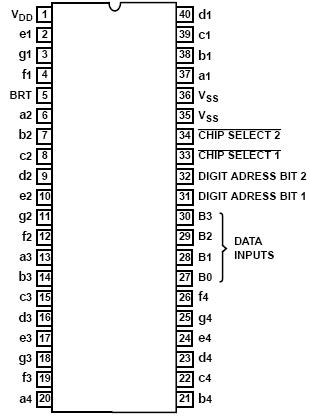Features: • Four Digit Non-Multiplexed 7 Segment LCD Display Outputs with Backplane Driver
• Complete Onboard RC Oscillator to Generate Backplane Frequency
• Backplane Input/Output Allows Simple Synchronization of Slave-Devices to a Master
• ICM7211 Devices Provide Separate Digit Select Inputs to Accept Multiplexed BCD Input (Pinout and Functionally
Compatible with Siliconix DF411)
• ICM7211M Devices Provide Data and Digit Address Latches Controlled by Chip Select Inputs to Provide a Direct High Speed Processor Interface
• ICM7211 Decodes Binary to Hexadecimal; ICM7211A Decodes Binary to Code B (0-9, Dash, E, H, L, P, Blank)
• ICM7211A Available in Surface Mount PackagePinout
SpecificationsSupply Voltage (VDD - VSS) . . . . . . . . . . . . . . . . . . . . . . . . . . . 6.5V
Input Voltage (Any Terminal) (Note 1) . . VSS - 0.3V to VDD, + 0.3VDescriptionThe ICM7211 (LCD) and ICM7212 (LED) devices constitute a family of non-multiplexed four-digit seven-segment CMOS display decoder-drivers.
The ICM7211 devices are configured to drive conventional LCD displays by providing a complete RC oscillator, divider
chain, backplane driver, and 28 segment outputs.
The ICM7212 devices are configured to drive commonanode LED displays, providing 28 current-controlled, low leakage, open-drain N-Channel outputs. These devices provide a brightness input, which may be used at normal logic levels as a display enable, or with a potentiometer as a continuous display brightness control.
These devices are available with multiplexed or microprocessor input configurations. The multiplexed versions provide four data inputs and four Digit Select inputs. This configuration is suitable for interfacing with multiplexed BCD or binary output devices, such as the ICM7217, ICM7226, and ICL7135. The microprocessor versions provide data input latches and Digit Address latches under control of high-speed Chip Select inputs. These devices simplify the task of implementing a cost-effective alphanumeric seven-segment display for microprocessor systems, without requiring extensive ROM or CPU time for decoding and display updating.
The standard devices of the ICM7212 will provide two different decoder configurations. The basic device will decode the four bit binary inputs into a seven-segment alphanumeric hexadecimal output. The "A" versions will provide the "Code B" output code, i.e., 0-9, dash, E, H, L, P, blank. Either device will correctly decode true BCD to seven-segment decimal outputs.

 ICM7212 Data Sheet
ICM7212 Data Sheet







